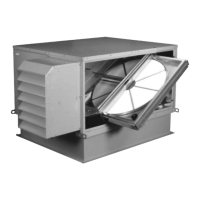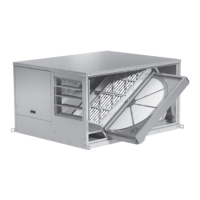ERV-251
First, remove the drive belts and the
collars on both bearings. On the pulley
side of the cassette remove the (4)
fasteners that hold the bearing support
channel in place. Once the bearing
support is removed the wheel can be
pulled from the cassette. To replace
the wheel reverse this procedure.
ERV-361, 521, 581, 522 & 582
(stainless steel rim)
Steel retainers are located on the inside
of the wheel rim (see Figure 11). Push
the retainer towards the center of the
wheel, then lift up and away to release
segments.
17
NOTE: PLACE RETAINERS BACK IN THE ORIGINAL
POSITION BEFORE ROTATING THE ENERGY
RECOVERY WHEEL. OTHERWISE DAMAGE
TO THE RETAINER WILL OCCUR.
REMOVING THE ENERGY RECOVERY WHEEL OR SEGMENTS
FIGURE 11
RECOMMENDED CLEANING PROCEDURE FOR ENERGY RECOVERY WHEELS
First, remove the energy recovery wheel segments by following the instructions on this page. (For one-piece
wheels smaller than 30 inches in diameter, remove the wheel from the cassette.)
Wash the segments or small wheels with a non-acid based (evaporator) coil cleaner or alkaline detergent
solution. Non-acid based coil cleaner such as KMP Acti-Clean AK-1 concentrate in a 5% solution has been
demonstrated to provide excellent results. Do not use acid based cleaners, aromatic solvents,
temperatures in excess of 140°F or steam; damage to the wheel may result. Soak in the cleaning
solution until grease and/or tar deposits are loosened. Internal heat exchange surfaces may be examined by
separating the polymer strips by hand. (Note: some staining of the desiccant may remain and is not harmful
to performance.)
After soaking, rinse the dirty solution from the wheel until the water runs clear. Allow excess water to drain
prior to replacing segments in the wheel or reinstalling the wheel in the cassette. A small amount of water
remaining in the wheel will be dried out by the airflow.
FREQUENCY OF ENERGY WHEEL CLEANING
A regular cleaning cycle must be established for the energy recovery wheel in order to maintain optimum
sensible and latent energy transfer. In reasonably clean environments such as schools, offices or retail stores,
the energy recovery wheel should be inspected annually and cleaned as needed.
For applications experiencing unusually high levels of tobacco smoke, such as lounges, nightclubs, bars and
restaurants, washing of the energy recovery wheel every six months may be necessary to maintain latent
energy (water vapor) transfer efficiency.
Failure to follow a regular cleaning cycle for the energy recovery wheel can result in significant energy transfer
performance losses.

